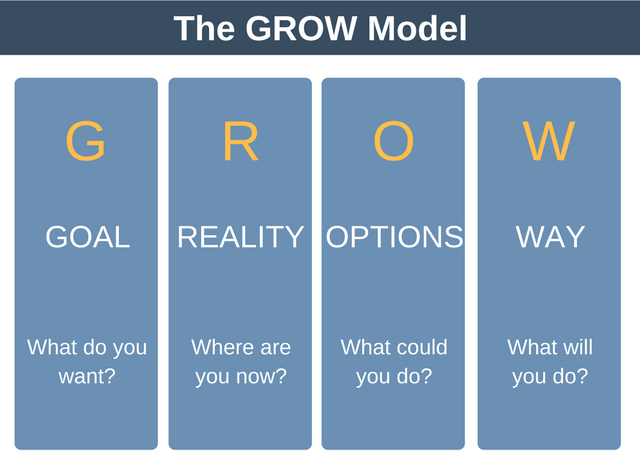
The GROW coaching model is a tried and tested coaching model to structure coaching sessions.
The power of the GROW coaching model is that it leads to a clearly-defined result through four phases. The coaches are personally active in identifying problems and generating ideas for solutions. This means that anything that comes out of the coaching session has a good chance to become habit.
The GROW coaching model stands for learning through experience: reflection, insight, making choices and pursuing them.
G – Goal setting for the session as well as for the short- and long-term.
R – Reality checking to explore the current situation.
O – Options and alternative strategies, or course of actions.
W – What is to be done, when, by whom, and the will to do it.
Click here to view a video that explains the GROW model.
Goal Setting
The first stage is to agree and understand the goal that the mentee wants to achieve in the session. This is important! Some questions to help with this are:
- What would you like to get out of this session?
- We have half an hour. Where would you like to have gotten to by then?
- What would be the most useful/helpful thing for you to take away from this session/time?
A Goals Should be:
- Smart, Pure, and Clear.
- Specific, Measurable, Agreed, Realistic, and Time-phased.
- Positively-stated, Understood, Relevant, and Ethical.
- Challenging, Legal, Environmentally-sound, Appropriate, and Recorded.
Agreeing on Goals:
- State positively what you want. What do you want?
- Find out what evidence they need to demonstrate success. How will you know when you have what you want? How will you look, sound, and feel? What will be the same/different? This is necessary for recognising success.
- Can you start and maintain the process to get what you want? What stops you from having it right now? What do you need? What is your first step?
- You presently do things which work, so what part of your present behaviour can you use to get what you want?
- In what context do you want this? Everywhere or somewhere specific? When do you want it – all the time? When, where, and with whom do you not want it?
- What are the costs of what you want? Is it worth the cost to you? What will you gain? What will you lose?
- Is it worth the time it is going to take?
- Is it what you want in keeping with your own purpose, your sense of self and identity?
Reality Checking
Once the goal is set you will need to explore the facts and feelings around the issue/problem/topic. This exploration is to raise the awareness and self-awareness of the individual. Awareness is defined as perceiving things as they really are, and self-awareness is recognising those internal factors that distort one’s own perception of reality.
To do this we often we need to tap into emotions:
- How did you/do you feel about...?
- What is the predominant feeling when...?
- What do you think you are afraid of?
- Can you give me a rating on a scale of 1 – 10 for your level of confidence in your ability to…?
Two reality questions that almost always contribute value is:
- What action have you taken on this so far? Followed by…
- What were the effects of that action? or, if the answer is ‘nothing’, What are the factors that prevented you from acting?
Options
Once your mentee is aware of the reality around the situation, they need to think about actions, solutions and ideas that will help resolve or move the situation forward. Having options is important as choice enables us to feel in control and empowered. It is even more powerful if those choices are our own and the choice, we make is also our own.
When asked to think about options for taking an issue forward we can be faced with negativity. This negativity comes from our own limiting beliefs. As a mentor we need to get people to see beyond these beliefs.
Some common negative responses are:
- I don’t know.
- It can’t be done.
- It can’t be done like that.
- They would never agree to that.
- It’s bound to cost too much/take too much time.
To unlock negativity, the following ‘what if...’ questions may work:
- What if you knew the answer? What would it be?
- What if the obstacle didn’t exist? What would you do then?
- What if you did have enough money/time?
The key is to identify the limiting belief; the solutions and choices are then much easier to find.
What is to be Done?
Once the choices for moving forward have been agreed, it is important that the mentee has fully bought into the action if they are to feel confident in completing it. This stage needs to cover the what, when, who (support/involved), and the will to do it. If this is not explored, you may think your mentee has left the session with agreed actions and be surprised to find that when you next meet that nothing has happened!
Some questions that may help are:
- What are you going to do?
- When are you going to do it?
- Will this action meet your goal?
- What obstacles might you meet along the way?
- Who needs to know?
- What support do you need?
- How and when are you going to get that support?
- What other considerations do you have?
- On a scale of 1-10, how confident are you that will carry out the actions agreed?
- What prevents it from being a 10?
- What would make it a 10 for you?
Click here to view a video that shows how the GROW model is applied in the workplace.